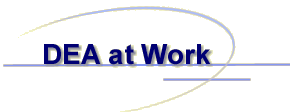

Annual federal expenditures for reducing the use of illegal drugs in the United States increased more than six times during the 1981/1998 period. Calculated in constant dollars, federal spending for a range of drug control purposes including operating the criminal justice system, interdiction and drug treatment came to slightly more than $16 billion in fiscal year 1998 compared with $2.7 billion in 1981. (See graph and table.)
Since 1992, however, the overall drug budget under Clinton, after controlling for inflation, has grown at a more modest pace – from $13.8 billion to $16.1 billion – up only 16 percent. This compares with the prior four years under Bush (1988 to 1992 ) where the drug budget had more than doubled (table). While the increase in the drug spending budget slowed during the Clinton years, the growth rate for the drug program still exceeded that racked up for all other federal government spending.
During the administrations of the last three presidents -- Reagan, Bush and Clinton -- significant changes have occurred in how the available dollars are spent with a growing share of the federal dollars being funneled to the criminal justice system (graph).
In 1998, for example, more than half of the overall budget --51.3 percent -- was set aside for the criminal justice system. In 1981, this part of the drug control budget only represented 27 per cent of the total. Much of the increased focus on criminal justice in the government's overall drug program came during the Reagan years. The relative emphasis changed little during the Bush years : 42.3% in 1988 versus 41.5% in 1992. During President Clinton's time in office, the part of the budget put aside for criminal justice jumped another 10 percentage points. (See table.)
The substantial increase in federal spending for criminal justice purposes during the 18-year period saw a broad decline in relative spending for drug treatment programs (table). During the Reagan years, drug treatment dropped from 33.5 percent of all drug expenditures to 18.4 percent and then remained in this general range so that by 1998 it was 17.5 percent. [Actual dollars for drug treatment (table) did increase because of the huge growth in the drug budget, just the relative emphasis declined.]
Funds for interdiction and international drug efforts rose during the Reagan years starting from 28.7 percent of the total in 1981 and rising to a peak of 33.8 percent in 1987, but then fell during the last year of the Reagan administration. The decline continued under both Bush and Clinton so that by 1998 only 14.7 percent of all drug dollars were being spent on interdiction. (See table.) This fall was so precipitous that despite the growth in the overall drug budget during the period, substantially fewer dollars in real terms were being spent in 1998 then at the beginning of this decade. (See table.)
The national policy decision to require major enforcement agencies such as the FBI, IRS, and INS to devote more of their resources to drug matters, is clearly visible in the proportion of the federal investigative budget spent by the DEA. While actual DEA spending increased during the 18-year period, its relative place among the agencies declined. In 1981, for example, DEA got three out of five (58.8%) of federal investigative dollars. But by 1992 the DEA only accounted for one out of every three dollars (32.3%). Since that low, the DEA has experienced a slight increase in drug budget share, accounting for 36.9 percent of the national 1998 drug investigations budget. (See graph and table.)
![]() | DEA at
Work | TRAC-DEA
|
| DEA at
Work | TRAC-DEA
|
